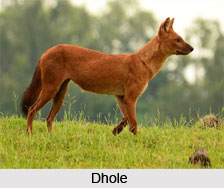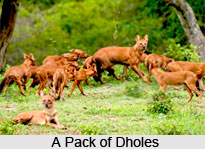 Dhole or the Indian wild dog is a pack-hunting carnivore that belongs to the Canidae family. Scientifically it is known as Cuon alpinus. The Dhole is a protected animal under Indian Wildlife Act, and has become the major attraction in many of the Indian sanctuaries.
Dhole or the Indian wild dog is a pack-hunting carnivore that belongs to the Canidae family. Scientifically it is known as Cuon alpinus. The Dhole is a protected animal under Indian Wildlife Act, and has become the major attraction in many of the Indian sanctuaries.
Features and Habitat of Dhole
An adult dhole normally weighs 18 kg, stands around 50 cm at the shoulder and the total length, including the 40-45 cm long tail, is approximately 130 cm. Female Indian wild dogs are slightly lighter in build. The fur is rusty sandy in colour with a somewhat paler ventrum. The bushy tail is black-tipped and may have a mixture of grey and white hairs.
Ten subspecies of such wild dogs have been reported to be found all over the world. In India, however, there are three subspecies: Cuon alpinus dukhunensis found south of the Ganga; C. a, primaevus in Kumaon, Nepal, Sikkim and Bhutan; and C. a. laniger which formerly occurred in Ladakh and northern Kashmir. As in other pack-hunting canidae, the Dhole pack is an extended family unit and the number in the pack rarely exceeds 20 animals, whilst groups of 5 to 12 are most common. Dholes are largely social. Packs are thought to be territorial and the area covered by the pack in its hunting is correlated with the abundance of prey. Dholes maintain an almost constant number in a given area and this is because breeding is restricted to one female in the pack, and emigration or mortality limits the numbers of both adults and pups. Not much is known about hierarchy in Dhole society. Pups are highly quarrelsome; sub-adults occasionally fight, whilst adults are amicable. One of the fascinating aspects of the Dhole society is the play indulged in by the adults and pups as well.
 Dholes become sexually mature in about one year. Gestation lasts for 60 or 62 days and in India, whelping occurs between November and March and the litter size is around 8. Prior to giving birth female Dhole prepares a den, usually an existing one, dug by porcupines on the banks of stream-beds or under or between rocks. The entire pack takes part in feeding the nursing the mother and the pups, which are fed with regurgitated meat when they are three weeks old. Sometimes a second Dhole, other than the mother, is seen near the den. Pups at the age of 70 to 80 days leave the den permanently, and if the den-site is disturbed, the pack will move the pups to a safer place.
Dholes become sexually mature in about one year. Gestation lasts for 60 or 62 days and in India, whelping occurs between November and March and the litter size is around 8. Prior to giving birth female Dhole prepares a den, usually an existing one, dug by porcupines on the banks of stream-beds or under or between rocks. The entire pack takes part in feeding the nursing the mother and the pups, which are fed with regurgitated meat when they are three weeks old. Sometimes a second Dhole, other than the mother, is seen near the den. Pups at the age of 70 to 80 days leave the den permanently, and if the den-site is disturbed, the pack will move the pups to a safer place.
Diet and Hunting Strategies of Dhole
Dholes feed on a wide variety of prey ranging from smaller mammals, such as, rodents to large deer. Common prey animals in India are chital, sambar, wild pig, hare and calves of domestic cattle. Dholes are predominantly diurnal and hunt mainly in the morning and evening. As a prelude to the hunt the dholes assemble at a defecation site, rub their bodies against others, nuzzle each other and after this mood-synchronizing ceremony, set off to hunt.
As far as hunting is concerned the Indian wild dogs commonly adopt two strategies. One is to kill prey as the whole pack moves through the scrub in an extended line and the other is for some members of the pack to remain on the periphery of the jungle so as to intercept the fleeing prey flushed out by other members of the pack. Small mammals like hare and chital fawn are seized on any part of the body and are killed with a single head-shake. Larger animals are attacked from behind and the usual points of attack are the rump and the flank. This leads to severe shock and the prey is eventually killed. Dholes eat fast and within 60 or 90 minutes each consumes nearly 4 or 5 kg of meat. Feeding dholes frequently drink water, if water is nearby. If water is some distance away, they head for the nearest water-hole soon after eating. Dholes do not cache food but come back for the remains.
Communication Method of Dhole
Communication involves vocalizations, olfactory and body language. Vocalizations include whine, growl, growl-bark, scream, whistle, and squeaks by the pups. Of all these, the whistle, which is a contact call, is the most prominent. It is still not understood how the Dhole produces this whistle call which is mainly used to reassemble after the pack members get dispersed after an unsuccessful hunt.



















